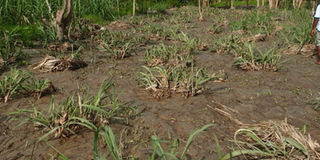Universities join efforts to combat climate change in East Africa

Floods are increasingly a common occurence in Uganda as the effects of climate change manifest in various parts of the country. FILE PHOTO
Agricultural productivity in East Africa is increasingly threatened by climate change, which is likely to impact negatively on development.
Countries in the region face a range of common development challenges. These include natural resource degradation, decreasing agricultural productivity, rapid population growth rate and high poverty level.
Due to economic and social inequalities, women are especially affected by the effects of climate change such as floods and drought.
Timely initiate
Like other Sub-Saharan African countries, Uganda is already affected by and vulnerable to climate change with most of the population and economy largely dependent on rain-fed agriculture.
Against this background, a collaborative project was developed to address national and regional challenges posed by climate change. It is managed at Makerere University’s College of Agricultural and Environmental Sciences. It involves Norwegian University of Life Sciences and Technology, Addis Ababa University and University of Juba.
The coordinator, Prof Samuel Kyamanywa of Makerere University, explained that it is timely to educate students, who will in turn reach out to farmers, who are vulnerable to effects of climate change.
He was giving an overview of the project during a recent meeting of Capacity Building for Sustainable Natural Resources Management and Agricultural Productivity under Climate Change (CAPSNAC)
The project, which started in 2014 will run for four years. It is funded by the Norwegian government to the tune of $1.7m (Shs 5.06b).
It encompasses the element of educating students, mainly from South Sudan at both Master’s and PhD levels. Farmers in the three countries will be sensitised on the need to manage the natural resources sustainably to avoid adverse effects of climate change.
Teach and guide
At Makerere Unversity, five South Sudanese students are pursuing Master’s degree courses. Seven more are yet to be enrolled. A total of 10 are doing PhDs; three from Uganda and five from South Sudan. The two from Ethiopia are at University of Addis Ababa.
Prof Kyamanywa contends that since study of climate change is relatively a new science, there is need to train the students to understand climate variability in order to guide the farmers.
For instance, teaching students the agronomy of managing a banana plantation did not include the climate change component. So, what they are trying to do to make sure that for farmers to produce high-yielding banana under drought, they must be given varieties developed for drought tolerance or resistance .
Take caution
During surveys, students and their lecturers interact with farmers in different locations mainly Eastern Uganda. This is around River Mpologoma catchment area in Mbale as well as Katakwi, where there is flooding, which leads to loss of crops such as rice grown in this region.
This explains the importance of farmers using the available water source such as wetlands for irrigation during dry season especially those farmers growing lowland rice varieties.
But caution must also be taken against substances, which interact with water in loose wetlands including bacteria and other pests and diseases, which may end causing destruction to agricultural activity.
Students and the scientists are expected to design a resilient farming system by liaising with meteorology personnel to develop early warning methods for farmers.
Affect farming
As seasons will keep changing, farmers are advised to adapt to crops, animals and poultry that are resilient to these changes in seasons.
Prof Frank Kansime, who conducted a survey with students in the Lake Kyoga area, explains that there is increasing rainfall with high temperatures on the other hand. This leads to landslides as well as droughts thereby affecting farming activities.
Iganga, Manafwa, Namutumba districts are faced with drought conditions during in the December- March period, and thus there is hardly any farming activity. Instead, there are alternate activities such as charcoal burning, brick-making, stone quarrying, collecting firewood which contribute to environmental degradation.
The long view
Dr Yazidhi Bamutaze, from Department of Geo-Informatics and Climate Science at Makerere University, in explaining dynamics of climate change in Eastern Africa puts the population that depends on the environment and natural resources at more than 70 per cent.
Climate change is real as this was witnessed by El Nino phenomenon in 1997 and 1998. With it, countries in Eastern Africa are vulnerable as crops from farmers’ fields are destroyed leading to food shortages. Therefore scientists are expected to address the situation in Uganda, and Africa at large, with innovations that can help farmers cope with the effects of climate change.
He projected what greenhouse gas emissions are likely to be cause in eastern Africa. By 2040, the monthly precipitation in Uganda will be worse with areas like Karamoja and Kabale becoming hotter. Temperatures will be increasing as rainfall drops.
As seasons keep changing, farmers are advised to adapt to crops, animals and poultry which are resilient.




